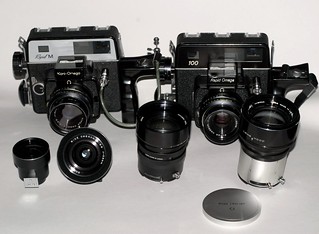Koni-Omega
The Koni-Omega is a class of medium format rangefinder cameras. These press cameras are 6×7cm (2 1/4" × 2 3/4") rangefinders with a combined viewfinder and coupled rangefinder, and automatic parallax and field-of-view compensation. Some cameras have fixed lenses while others have interchangeable lenses. Still others have interchangeable backs. All cameras use medium format roll film. Not including the military cameras (e.g., PH-501/PF) the first camera in what would later become the Koni-Omega system was released in 1954, and the Rapid Omega 100 ended production in 1981. Despite having American origins these cameras were produced in Japan for most of their production run.
Contents
Camera details
The Simmon Brothers, known for their line of enlargers, built the original Simmon Omega. The Omega 120 camera was design by Alfred Simmon.[1] The designs of later cameras were likely by Berkely Brothers and Konica. The product was principally by Konica.
There are ten 6×7cm exposures to a roll of 120 film and 20 to 220 film roll. However, the 220 film backs are less common than the 120 backs. All cameras have interchangeable film backs, thus allowing the photographer to prepare additional loaded backs while the camera is in use. The Koni-Omega Rapid M, Koni-Omega M, Koni-Omegaflex M and Rapid Omega 200 also feature fully-enclosed film magazines that allow for mid-roll film exchange. The film advance is via a pull-push operation on a handle on the side of the camera. This makes for fast advancing, and along with the ability to quickly load new film magazines this explains the use of the name Rapid.
The lenses are focused by a large knob above the film advance. The entire lens mount moves in and out with a rack-and-pinion system. The bright-line framing in the rangefinder is determined by the focus and one or more pins protruding from the rear of the lens. There is a large grip on the other side of the camera near the shutter release. No light meter is included in these cameras. All cameras allow both M and X flash synchronization.
The cameras with enclosed film magazines require a dark slide to change lenses or film backs. The cameras with film backs include an integrated internal baffle curtain that must be closed to change lenses. In both cases these systems are part of an interlock system that prevents the shutter from being fired with either a dark slide in place or if the curtain is closed. Due to the exposed linkage between the winder and the lens shutter, double exposures are possible with all cameras, but accidental double exposures are rare as it requires the photographer to manually cock the shutter using a small lever that is recessed under the lens.
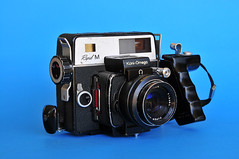 
|
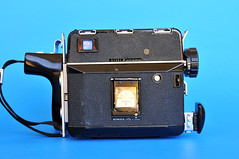 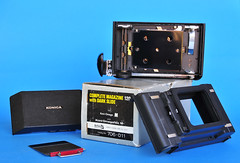
|
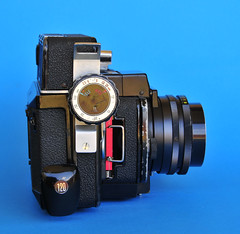
|
| Koni-Omega Rapid M images by Dirk HR Spennemann (Image rights) | ||
List of models
- Combat Camera PH-501/PF
- Omega 120
- Omega 120 KE-8
- Koni-Omega Rapid
- Konica Press
- Koni-Omega Rapid M
- Koni-Omega M
- Konica Press 2
- Rapid Omega 100
- Rapid Omega 200
- Rapid Omega 200 KE-58
List of lenses
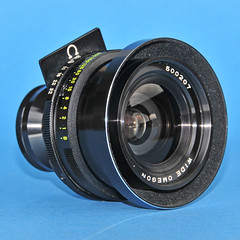 58mm f/5.6 |
 135mm f/3.5 |
 135mm f/3.5 |
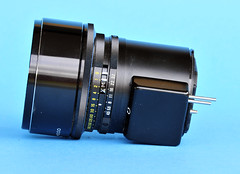 180mm f/4.5 |
| images by Dirk HR Spennemann (Image rights) | |
Lenses available include:
- 58mm f/5.6 (eight elements in four groups)[2]
- 60mm f/5.6 (six elements in four groups)[3]
- 90mm f/3.5 (four elements in three groups)[2][3]
- 135mm f/3.5 (six elements in five groups)[3]
- 180mm f/4.5 (five elements in four groups)[2][3]
The normal lens is a 90mm f/3.5 Tessar with shutter speeds from 1 to 1/500 sec and a minimum aperture of f/32. The 58mm and 60mm wide-angle lenses are widely believed to have the same optical design, but the lens diagrams contained in the user manuals prove this wrong.[4] (One of these, or both, may have an Aviogon or Biogon design.) Framing requires use of an accessory finder. The 135mm lens is less common than the other lenses. The 180mm f/4.5 is roughly equivalent to 100mm for a 35mm camera. It focuses down to 12 feet, close enough for portrait use.
Gallery
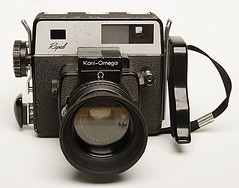
|
| Koni-Omega Rapid image by Rick Soloway (Image rights) |
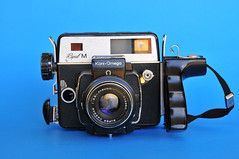
|
| Koni-Omega Rapid M image by Dirk HR Spennemann (Image rights) |
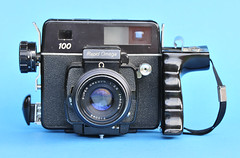
|
| Rapid Omega 100 image by Dirk HR Spennemann (Image rights) |

|
| Rapid Omega 200(ke-58) image by Dirk HR Spennemann (Image rights) |
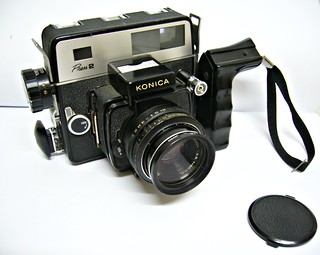
|
| Konica Press 2 image by cgancedo65 (Image rights) |
Compared
| Omega 120 | Koni-Omega Rapid | Koni-Omega Rapid M | Koni-Omega M | Rapid Omega 100 | Rapid Omega 200 | |
|---|---|---|---|---|---|---|
| Year | 1953 | 1964 | 1967 | 1968 | 1975 | |
| Producer | Simmon | Konica | Mamiya | |||
| Film | 120 film | 120 / 220 roll film | ||||
| Mid-roll film | No | Yes | No | Yes | ||
| Frame | 90mm, 180mm | 90mm, 135mm, 180mm | ||||
Notes
- ↑ Simmon camera US D169343 at Google Patents
- ↑ 2.0 2.1 2.2 User manual of the Koni-Omega Rapid available at Mike Butkus' Orphan Cameras
- ↑ 3.0 3.1 3.2 3.3 User manual of the Koni-Omega Rapid M available at Mike Butkus' Orphan Cameras.
- ↑ This was pointed at by JRG in this thread at Rangefinderforum.
Bibliography
- Asahi Camera (アサヒカメラ) editorial staff. Shōwa 10–40nen kōkoku ni miru kokusan kamera no rekishi (昭和10–40年広告にみる国産カメラの歴史, Japanese camera history as seen in advertisements, 1935–1965). Tokyo: Asahi Shinbunsha, 1994. ISBN 4-02-330312-7. Items 1292–3.
- Lewis, Gordon, ed. The History of the Japanese Camera. Rochester, N.Y.: George Eastman House, International Museum of Photography & Film, 1991. ISBN 0-935398-17-1 (paper), 0-935398-16-3 (hard). Pp.120 and 123.
- McKeown, James M. and Joan C. McKeown's Price Guide to Antique and Classic Cameras, 12th Edition, 2005-2006. USA, Centennial Photo Service, 2004. ISBN 0-931838-40-1 (hardcover). ISBN 0-931838-41-X (softcover). Pp.538 and 545.
- Sugiyama, Kōichi (杉山浩一); Naoi, Hiroaki (直井浩明); Bullock, John R. The Collector's Guide to Japanese Cameras. 国産カメラ図鑑 (Kokusan kamera zukan). Tokyo: Asahi Sonorama, 1985. ISBN 4-257-03187-5. Items 6068–9.
Links
General links
- The Koni-Omega pages at Peter Lanczak's website
- Koni-Omega Rapid M at Photoethnography by Karen Nakamura
- JJ's French language page on the Koni-Omega (archived)
- Rapid reviewed by Davidde Stella -- via Wayback Machine, therefore slow.
- Koni Rapid Omega page by Robert Monaghan et al. via the Wayback Machine, therefore slow.
- Koni-Omega instruction manuals at Orphancameras.com
- "A second look", Robert Carter, 2004, Email Journal of the Photographic Historical Society of Canada, Volume 4, number 2, p. 2.
- Original 1954 advertisement reproduced in the Email Journal of the Photographic Historical Society of Canada, Volume 4, number 2, p. 3.
- Design Patent for Photograph Camera by Alfred Simmon
- Rangefinder improvement patent for the Koni Omega.
- Koni-Omega Rapid 100 video presentation by YouTuber Kay's Cameras
